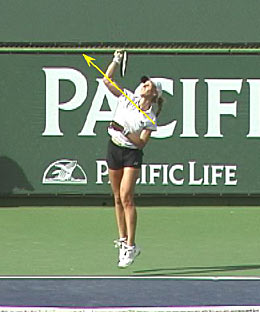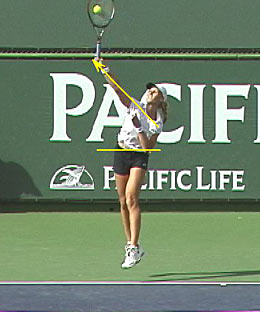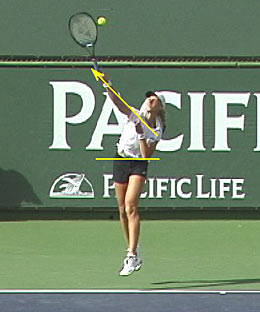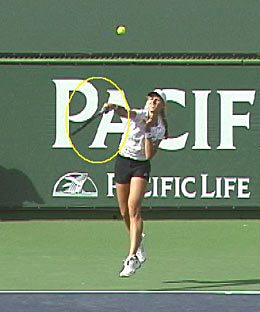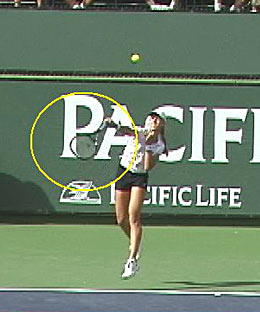|
TennisOne Lessons Elena Dementieva and Developing the Side-Spin Serve Jim McLennan
The Russian women owned the women’s tour in 2004 – Sharapova won Wimbledon, Myskina beat Dementieva at the French, and Kuznetsova captured the US Open. To my eye, I saw a dominating ground game (Sharapova and Kuznetsova) and incredible court management (Myskina) but really, not a good serve to be found anywhere. It seemed that the more I looked, the more I found about movement, about balance, about ballet as an underpinning to the Russian coaches (if not the players) and that somehow these movement skills were the key to their ascendancy. And of all the suspect servers, no one was more remarkable than Elena Dementieva, who served up a slew of double faults in her losing French Open to Myskina. Commentators had a field day with Elena’s service motion, dissecting an errant toss, hesitant delivery, and low point of contact. But, in her quarterfinal victory over Lindsay Davenport in the 2005 US Open, and her excruciatingly close loss to eventual finalist Mary Pierce in the semifinals, it appeared that her side spin serve has become deceptively strong.
The contact is still low and out to the right, and there are still the double faults but her unique side spin creates problems for the girls on tour. In the deuce court it curves wide and stays low, driving the receiver well into the alley, but equally forcing them to play the ball from below the level of the net. Davenport appeared to lose her nerve on the forehand in this scenario, and this crack in Lindsay’s armor seemed to migrate throughout her game, punctuated by many a tentative forehand, not only when returning but also when rallying. The path of the serve and how it bounces is influenced by the height of contact, by the apex of the serve after contact, and by the direction of the spin. Generally, most of the women serve tall, that is they are fully extended at contact, and generally most serve with significant topspin. As a result, nearly all of these serves rise into the receiver’s contact zone, and cross the baseline and into the receiver’s strike zone well above their waist. Well, similar to an effective pitcher who may not have the heat but pitches with a delivery unlike all the others, Elena’s serve arrives at a speed, with a direction, and considerably lower contact point than all the others, creating considerable problems. The Side spin Serve Let’s take a closer look at this wicked side spin delivery. At the release of the toss, Elena is in a classical position (Figure 1). Her weight is balanced on the back foot. She has turned away from the receiver to begin the motion - note the tossing arm to her side and positioned parallel to the baseline. She releases the toss at eye level. Her right arm and racquet are moving slowly and are still down as her left side rises with the toss.
Whereas it seems that most of the men (including Federer, Roddick, Agassi, and Sampras) do not move their feet while tossing, but rather stay more or less balanced after the toss and simply sink and then drive up and into the ball, most of the women move their feet during the serve, bringing the back foot up next to the front foot, then sinking down and driving up and into the ball. I am not sure why, or to what benefit or detriment, but as with most of the women, Elena moves her back foot after the toss, but doesn’t place it back down (Figure 2). When crouching on one leg there is less thrust available then when crouching in a balanced position on two legs. At impact her racquet is well to the right, not really serving tall. But I argue, this is the first real element that produces this low bounding delivery. Note the straight line from her left shoulder through her right shoulder continuing to her hand (Figure 4). In the topspin version of this serve a similar straight line can be drawn, but in that case the line is more or less vertical. Note the horizontal line across her hips. This suggests she turns into the hit much like a forehand, but clearly her right side (including her right knee, right hip, right shoulder, and right hand) is not very high.
As she meets the ball her racquet is sliding to the right, such that the force of the swing is used more to impart spin than to impart ball speed. And even now her right side is no higher than in the previous photo.
Throughout her service action (meaning her racquets actual hitting of the ball), she is snapping her wrist around the ball, peeling the orange as it were. This wrist snap (which is not a forearm roll so commonly seen at a similar moment in the Roddick, Federer or Sampras delivery) actually takes a little pace off the ball but increases yet again the amount of side spin
In figure 7, from the receiver’s point of view, we can clearly see the ball breaking to our right, and once again we will be forced out into the alley to try and dig this ball up and over the net. In contrast to peeling the orange” the photo in Figure 8 captures a bigger serve. Even though her right side remained as low as in the other delivery, note how her forearm has turned out. This release of the racquet is similar to the action seen with the bigger servers, and may be something she and Richard Krajicek have worked on to add zip and penetration to her serve. The net effect is a serve that breaks quickly from left to right (from the receiver’s point of view) and bounces very low. When returning this ball from well inside the baseline, well outside the alley, and well below the level of the net, a real decision must be made. Either play a basic crosscourt to get back into the point (and not really attack the ball) or go for it with a big shot down the line. Generally one goes up the line with the forehand if the court is open, if the ball is above the net, if the player is inside the baseline, or if the player is approaching the net. But when stretched out wide and low, the down the line is not all that easy. Elena is not out of position, if the ball is driven down the line cautiously (read Davenport) instead of boldly, Elena can whip a backhand crosscourt into the open court with relative ease and deadly accuracy.
To add this serve to your own kitbag (and in my neck of the woods it is a crafty Jim Miller who owns the left handed version of this wicked side spin delivery to the ad court), the trick is to toss low and to the right (for right-handers) and swing dramatically around the ball. The continental grip is a must, and if at all possible an eastern backhand works even better. With either grip the racquet is positioned with the edge of the frame leading as the racquet approaches the ball. Additionally, rather than swinging forward and at the service court, this motion feels like I am swinging at the right net post, and for the extreme side spin the swing is even more to the right. The follow through finishes past the left leg, as it would on other serves, but with the angle of the racquet face and the direction of the swing, the entire intent is side spin Aim for a spot well up the service sideline, two or three racquet lengths from the corner. Rather than serving tall, or hitting up and through the ball, lower is better than tall and spinier is better than flush. When mastered, you will find many an opponent over hitting their down the line reply, either into the top of the net or well beyond your baseline. Your comments are welcome. Let us know what you think about Jim McLennan's article by emailing us here at TennisOne.
|
||||||||||||||||||



